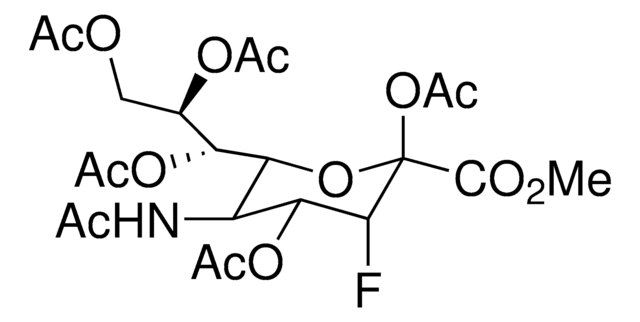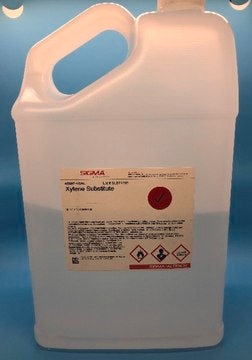344827
Fucosyltransferase Inhibitor, 2F-Peracetyl-Fucose
2F-Peracetyl-Fucose is a cell-permeable fluorinated fucose derivative that acts as an inhibitor of fucosyltransferases following its uptake and metabolic transformation into a GDP-fucose mimetic.
Synonym(s):
Fucosyltransferase Inhibitor, 2F-Peracetyl-Fucose, (3S,4R,5R,6S)-3-fluoro-6-methyltetrahydro-2H-pyran-2,4,5-triyl triacetate
Sign Into View Organizational & Contract Pricing
All Photos(1)
About This Item
Empirical Formula (Hill Notation):
C12H17FO7
Molecular Weight:
292.26
UNSPSC Code:
12352111
NACRES:
NA.77
Recommended Products
Quality Level
assay
≥98% (NMR)
form
solid
manufacturer/tradename
Calbiochem®
storage condition
OK to freeze
protect from light
color
white
solubility
DMSO: 10 mg/mL
shipped in
ambient
storage temp.
−20°C
General description
A cell-permeable fluorinated fucose derivative that acts as an inhibitor of fucosyltransferases following its uptake and metabolic transformation into a GDP-fucose mimetic. Treatment of HL-60 cells with this inhibitor shows complete abolition of Lewis-X and SLex within 3 days. Also abolishes P-selectin binding and exhibits faster rolling cells on E-selectin and P-selectin coated surfaces. Does not affect cell viability or their doubling time even at 200 µM levels.
Biochem/physiol Actions
Cell permeable: yes
Primary Target
Fucosyltransferase
Fucosyltransferase
Reversible: yes
Packaging
Packaged under inert gas
Warning
Toxicity: Standard Handling (A)
Reconstitution
Following reconstitution, aliquot and freeze (-20°C). Stock solutions are stable for up to 3 months at -20°C.
Other Notes
Rillahan, C., et al. 2012.. Nat. Chem. Bio.8, 661.
Legal Information
CALBIOCHEM is a registered trademark of Merck KGaA, Darmstadt, Germany
Storage Class
11 - Combustible Solids
wgk_germany
WGK 1
flash_point_f
Not applicable
flash_point_c
Not applicable
Certificates of Analysis (COA)
Search for Certificates of Analysis (COA) by entering the products Lot/Batch Number. Lot and Batch Numbers can be found on a product’s label following the words ‘Lot’ or ‘Batch’.
Already Own This Product?
Find documentation for the products that you have recently purchased in the Document Library.
Martina Zimmermann et al.
Biotechnology and bioengineering, 118(5), 1818-1831 (2021-01-28)
The reduction of antibody core-fucosylation is known to enhance antibody-dependent cellular cytotoxicity (ADCC). In this study, 5-Thio-l-Fucose (ThioFuc) was investigated as a media and feed supplement for modulating the fucosylation profile of therapeutic proteins and, thereby, improving the resulting effector
Sotiria Pinioti et al.
Cancer immunology research, 11(12), 1611-1629 (2023-11-07)
Forkhead box P3 (Foxp3)-expressing regulatory T cells (Treg) are the guardians of controlled immune reactions and prevent the development of autoimmune diseases. However, in the tumor context, their increased number suppresses antitumor immune responses, indicating the importance of understanding the
Natalie K Thulin et al.
Cell reports, 31(6), 107642-107642 (2020-05-14)
Infant mortality from dengue disease is a devastating global health burden that could be minimized with the ability to identify susceptibility for severe disease prior to infection. Although most primary infant dengue infections are asymptomatic, maternally derived anti-dengue immunoglobulin G
Rebecca Yun et al.
Cell death & disease, 14(8), 546-546 (2023-08-24)
KIAA1324 is a transmembrane protein largely reported as a tumor suppressor and favorable prognosis marker in various cancers, including gastric cancer. In this study, we report the role of N-linked glycosylation in KIAA1324 as a functional post-translational modification (PTM). Loss
Sarah Bui et al.
Methods in molecular biology (Clifton, N.J.), 2557, 453-493 (2022-12-14)
In this chapter, we provide a detailed guide for the application of commonly used small molecules to study Golgi structure and function in vitro. Furthermore, we have curated a concise, validated list of endomembrane markers typically used in downstream assays
Our team of scientists has experience in all areas of research including Life Science, Material Science, Chemical Synthesis, Chromatography, Analytical and many others.
Contact Technical Service







